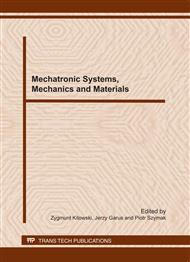[1]
J. Antoni, R.B. Randall, Differential diagnosis of gear and bearing faults, ASME Journal of Vibration and Acoustics 124/2 (2002) 165–171.
DOI: 10.1115/1.1456906
Google Scholar
[2]
J. Antoni, R.B. Randall, Unsupervised noise cancellation for vibration signals. Part I—evaluation of adaptive algorithms, Mechanical Systems and Sign. Proc. 18/1 (2003) 89–101.
DOI: 10.1016/s0888-3270(03)00012-8
Google Scholar
[3]
R. Zimroz, W. Bartelmus, Gearbox condition estimation using cyclo-stationary properties of vibration signal, Key Engineering Materials 413-414 (2009) 471-478.
DOI: 10.4028/www.scientific.net/kem.413-414.471
Google Scholar
[4]
R. Boustany, W. Bartelmus, J. Antoni, R. Zimroz, Application of Spectral Correlation Techniques on Mining Machines Signals: Extraction of Fault Signatures, 2nd World Congress on Engineering Asset Manag. and the 4th Int. Conf. on Condition Monitoring, 2007, Harrogate, UK, 320-326.
Google Scholar
[5]
W. Bartelmus, R. Zimroz, Vibration condition monitoring of planetary gearbox under varying external load, Mechanical Systems and Signal Processing 23 (2009) 1528-1534
DOI: 10.1016/j.ymssp.2008.03.016
Google Scholar
[6]
W. Bartelmus, R. Zimroz, A new feature for monitoring the condition of gearboxes in non-stationary operation conditions. Mechanical Systems and Sign. Proc. 23 (2009) 1528-1534
DOI: 10.1016/j.ymssp.2009.01.014
Google Scholar
[7]
W. Bartelmus, F. Chaari, R. Zimroz, M. Haddar, Modelling of gearbox dynamics under time varying non-stationary operation for distributed fault detection and diagnosis, European Journal of Mechanics - A/Solids, 29 (2010) 637-646
DOI: 10.1016/j.euromechsol.2010.03.002
Google Scholar
[8]
W. Bartelmus, Root cause and vibration signal analysis for gearbox condition monitoring, Insight 50/4 (2008) 195-201
DOI: 10.1784/insi.2008.50.4.195
Google Scholar
[9]
R. Boustany, Séparation Aveugle à l'Ordre Deux de Sources Cyclostationnaires: application aux Mesures Vibroacoustiques, PhD Thesis, UTC Compiegne, France, (2005)
Google Scholar
[10]
L. Gelman, R. Zimroz, J. Birkel, H. Leigh-Firbank, D. Simms, B. Waterland, G.Whitehurst, Adaptive vibration condition monitoring technology for local tooth damage in gearboxes, Insight: non-destructive testing and condition monitoring 47/8 (2005) 461-464
DOI: 10.1784/insi.2005.47.8.461
Google Scholar
[11]
G.K. Chaturvedi, D.W. Thomas, Adaptive noise cancelling and condition monitoring, Journal of Sound and Vibration 76 /3 (1981) 391–405.
DOI: 10.1016/0022-460x(81)90519-8
Google Scholar
[12]
Haykin S., Adaptive Filter Theory, Prentice-Hall, New Jersey, 1996.
Google Scholar
[13]
D. Ho, Bearing diagnostics and self-adaptive noise cancellation, Ph.D. Thesis, University of New South Wales, Australia, 1990.
Google Scholar
[14]
I. Khemili, M. Chuchane, Detection of rolling element bearing defects by adaptive filtering, European Journal of Mechanics A/Solids, 24 (2005) 293–303.
DOI: 10.1016/j.euromechsol.2004.10.003
Google Scholar
[15]
S.K. Lee, P.R. White, The enhancement of impulsive noise and vibration signals for fault detection in rotating and reciprocating machinery, Journal of Sound and Vibration, 217/3 (1998) 485-505.
DOI: 10.1006/jsvi.1998.1767
Google Scholar
[16]
S. Radkowski,Vibration based low energy damages detection, ITE Press, Radom, 2002.
Google Scholar
[17]
R.B. Randall, Y. Li, Diagnostics of planetary gear bearings in the presence of gear vibrations, Proceedings of Second International Conference on Gearbox Vibration and Diagnostics, Imeche, London, (1995) 73–80.
Google Scholar
[18]
R. M. Stewart, Some useful data analysis techniques for gearbox diagnostics, Applications of time Series Analysis, ISVR, University of Southampton, 1977.
Google Scholar
[19]
B. Widrow, S. Stearns, Adaptive Signal Processing, Englewood Clis NJ: Prentice-Hall, 1985.
Google Scholar
[20]
Y. Shao, K. Nezu, Design of mixture de-noising for detecting faulty bearing signals, Journal of Sound and Vibration 282 (2005) 899–917.
DOI: 10.1016/j.jsv.2004.03.051
Google Scholar
[21]
J.R. Zeidler et al., Adaptive enhancement of multiple sinusoids in uncorrelated noise, IEEE Trans. Acoustic, Speech, Signal Process. ASSP-26/3 (1978) 240–253.
DOI: 10.1109/tassp.1978.1163074
Google Scholar
[22]
T. Zieliński, Digital Signal Processing – from theory to practice (in Polish), WKiL, Warszawa, 2005.
Google Scholar
[23]
R. Zimroz, Application of signals separation/extraction techniques for diagnostics of driving units in mining machines, Proceedings of The Fifth International Conference on Condition Monitoring and Machinery Failure Prevention Technologies (CM 2008/MFPT 2008), Edinburgh, Coxmoor Publ., (2008) 1578-1592
Google Scholar
[24]
F. Combet, R. Zimroz, A new method for the estimation of the instantaneous speed relative fluctuation in a vibration signal based on the short time scale transform, Mechanical Systems and Signal Processing 23 (2009) 1382 – 139.
DOI: 10.1016/j.ymssp.2008.07.001
Google Scholar
[25]
T. Barszcz, Decomposition Of Vibration Signals Into Deterministic And Nondeterministic Components And Its Capabilities Of Fault Detection And Identification, Int. J. Appl. Math. Comput. Sci., 19/2 (2009) 327–335
DOI: 10.2478/v10006-009-0028-0
Google Scholar
[26]
R.B. Randall, J. Antoni, Rolling element bearing diagnostics—A tutorial, Mechanical Systems and Signal Processing 25/2 ( 2011) 485-520
DOI: 10.1016/j.ymssp.2010.07.017
Google Scholar


